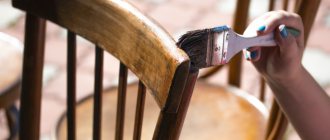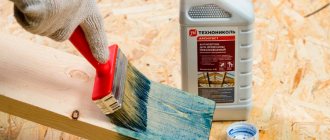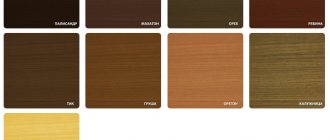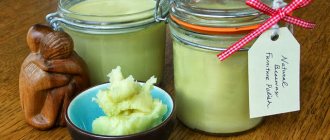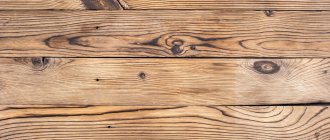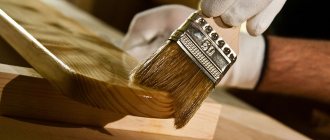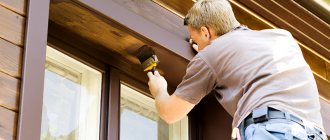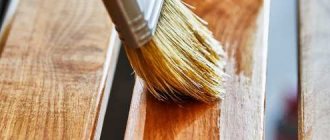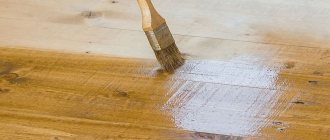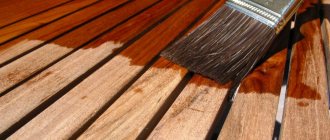These days there are a large number of varieties of varnishes: bitumen, acrylic, polyurethane. They are distinguished by application features, components, and application possibilities. Wood varnish for interior work, odorless, water-based, is used indoors, while yacht varnish is more often used for outdoor work. Features of varieties of varnishes, methods of applying them, pros and cons - find out in the article.
Content
- Water-based acrylic varnish for wood
- Polyurethane varnish for wood
- Two-component
- Yacht varnish for interior woodwork
- Matte wood varnish
- Characteristics of odorless interior varnishes Wear resistance
- Toxicity
- Drying
- Fire resistance
- Colored and colorless
Deception is everywhere
Which quick-drying varnish to choose for parquet? Any quality product, just not the kind sold in plastic buckets or other bulk containers.
Companies BONA, LOBA, FORBO and others pack varnish in a plastic or tin canister with a volume of 5 or 10 liters. The same goes for prices. A high-quality two-component composition cannot cost 300 rubles per liter.
Water-based acrylic varnish for wood
Water-based acrylic varnish for wood is used for furniture and flooring. The film turns out to be incredibly durable, so the composition is widely used. It is often applied to the floors of rooms with a large flow of people.
To obtain a film, the acrylic composition is diluted with water. Next, you should coat the surface with varnish. After the liquid dries, an elastic but durable layer forms on the wood. The composition penetrates into the pores of the wood, enhancing the adhesion of the film.
Water-based acrylic varnish for wood
After complete drying, the surface coated with acrylic solution becomes waterproof. The film cannot be removed.
Tip: Don't forget to clean the surface thoroughly! Remove debris and lumps. Be careful when working with the glossy version. All roughness and debris under the film will remain visible!
Let's consider the advantages of using water-based acrylic compounds:
- Cost-effective - applied in a thin layer, due to this, less material is consumed. A definite plus when working with large surfaces.
- Water resistance , protection from sunlight, fungi and insects. After drying, the film does not allow moisture to pass through, as it impregnates all the pores of the wood. This also helps protect against other destructive factors.
- Wood strengthening – fills voids in wood, strengthening its structure.
- Aesthetic appearance - wood coated with a water-based acrylic composition looks more beautiful than untreated wood.
- Protection from mechanical damage - the film is elastic after drying. This property prevents the consequences of some scratches and impacts. Mainly concerns the matte version.
- They have no smell.
- Non-toxic.
- Fire safety.
Parquet varnish technology
In order for odorless parquet varnish to be applied with precise adherence to technology, the room temperature should be about 25 °C. This temperature regime will ensure high-quality coating and high drying speed of the material. Before treating wood with varnish, it is recommended to thoroughly prepare the surface, which will create a smooth and durable coating without wrinkles or other defects.
Preparatory work
If the parquet is freshly laid, it should be thoroughly dried and then scraped and sanded. The floor can be scraped manually using a manual scraper or automatically using a professional machine. During the work, the top layer of wood is removed from the parquet, thanks to which almost all microcracks, scratches and unevenness are eliminated.
After sanding, surface grinding is performed, which will remove any remaining scratches and defects. Next, the gaps and cracks between the dies are covered with a special mastic, on top of which finishing sanding is carried out with fine-grained sandpaper. Before applying odorless parquet varnish, it is necessary to thoroughly clean the parquet from dust and apply a primer. To carry this out, you can use a primer varnish that ensures good adhesion of the wood to the final varnish coating.
Varnish application technique
The composition is applied with a brush, roller or spray. The latter option is considered the best because it is economical and provides high-quality coverage even in hard-to-reach places. If two-component varnishes are used, all their components must be mixed before starting work. When using the spraying method, the material must be diluted with a solvent.
As a rule, odorless parquet varnish is applied in 2-3 layers, but in some cases this number can increase to five. First, the floor is covered with the first layer, which is left until completely dry. Next, sand the parquet board, vacuum the floor and apply a second layer. After it dries, the boards are sanded again and cleaned of dust. The finishing layer is polished with a grinding machine with wool attachments and mastic or oil is applied for manual polishing.
| Buy |
Polyurethane varnish for wood
Polyurethane varnish for wood is easy to apply to any surface. An ideal solution for open and semi-closed furniture facades. Professional craftsmen apply polyurethane to obtain a mirror-like wooden surface.
Before this, painting procedures with other types of varnishes (up to 4 layers), sanding and polishing are carried out. After using the polyurethane composition, a specialized paste is taken using water. The craftsmen grind and polish it again. The mirror surface is ready.
Polyurethane varnish for wood
The compositions of recent years are made on the basis of fatty acids. They combine the best properties of aqueous and anhydrous. In addition to increased resistance to damage, they also do not react with household chemicals.
- High quality coating.
- Stronger than acrylic.
- Average price.
- Doesn't take long to dry.
- Toxicity.
Concrete floor varnish
Concrete floors can also be varnished
Concrete floors can also be varnished and they will look no worse than oak or larch parquet. Why varnish a concrete floor? When pouring the base, the so-called “cement laitance” is formed at the top, which turns into dust in a very short time. And varnishing will protect the base from destruction and not breathe in excess dust clouds during the entire service life. The main thing is to choose the right composition:
- Polyurethane varnish. An expensive coating with the highest technical and practical characteristics. No toxins, no allergic fumes, quick drying, protection from moisture and immunity to temperature changes are the main advantages of the material. In addition, the varnish resists abrasion very well, maintaining the original appearance of the base for a long time.
- A composition based on epoxy and bitumen resins also works well on concrete. But despite all its practicality, the varnish is afraid of moisture, so it is better to use the composition in rooms where wet cleaning is not expected. The composition dries quickly and has one unique quality - even with uneven application, a perfectly smooth surface is formed.
- Acrylic varnishes for concrete floors are as good as polyurethane varnishes, but they are “afraid” of water. But the abrasion of the coating is much higher, and the material consumption is less.
Concrete floors also need proper care, this will keep the protective layer in good condition for a long time.
Two-component
Two-component wood varnish is so named because it consists of two parts. The first of them is the varnish itself, the second is the hardener. Mix the components just before use. You cannot combine them in advance - the composition will be damaged.
Two-component wood varnish
Two-component varnishes are the most wear-resistant type of varnish. They are:
- opaque (different colors);
- glossy;
- transparent.
All two-component solutions are divided into three categories:
- on synthetic resins (polyurethane and alkyd);
- on formaldehyde resins (acid curing);
- water based.
The most environmentally friendly option for home and indoor spaces would be water-based varnish. It is somewhat inferior to polyurethane in strength, but, unlike the latter, does not cause allergic reactions.
The alkyd composition has a strong chemical smell, which is not suitable for everyone.
Tip: When purchasing a varnish made of two components, first of all find out the strength category. It is usually indicated on the packaging. For an apartment it is suitable for medium strength, for increased load - used in public spaces. In crowded places, a particularly durable composition is used.
Acrylic compounds
The base is a resin that partially contains water (another modification of dispersion compositions). After it evaporates, the film becomes solid. It is advisable to use acrylic varnishes for processing furniture, floors or wall cladding in rooms with large glazing. Or in intensely sunlit areas.
Pros:
- Resistant to temperature changes, ultraviolet radiation, household chemicals and liquids.
- The absence of toxic substances makes such varnishes “environmentally friendly”.
- There is no smell.
- A certain elasticity, which avoids cracks due to minor deformations of the wood.
Minuses:
- Working with acrylic varnishes in a cold room will not work if you think about the quality of wood processing. Minimum temperature +5 is the limit.
- Storage is only in a warm room, which causes some difficulty. Violation of this requirement will result in the paintwork material becoming unsuitable for further use.
Price – from 455.
Yacht varnish for interior woodwork
Yacht varnish for interior woodwork without odors was originally intended for ships. The housings were impregnated with it outside and inside. Gradually, builders, noting the high moisture-resistant properties of the liquid, began to use it for exterior and interior decoration.
Yacht varnish for interior woodwork
The use of yacht varnish for interior decoration is recommended in non-residential premises. Such compositions are very unsafe for health due to their high toxicity.
Yacht composition is often used when processing wooden structures standing in the open air. Excellent for covering gazebos and garden furniture. It is also used for the facades of wooden buildings and structures.
Tip: Before application, the surface must be thoroughly cleaned and sanded. Remove dirt and mold. The tree must be completely dry.
Important: Yacht varnish cannot be placed on top of drying oil. We'll have to clear the tree!
Before applying the composition, use a primer or fill the pores with a special composition.
- Increased moisture resistance.
- Increased wear resistance.
- Chemical resistance.
- Increased toxicity, leveled by their use in the open air.
Caring for varnished floors
Floors coated with odorless parquet varnish require careful maintenance. This will extend the life of the coating and keep it in its original form. Longer service life of varnished parquet can be achieved by following a few simple tips:
- After applying the varnish, it is permissible to walk on the parquet only after a few days;
- the carpet can be laid on the surface 10–12 days after varnishing;
- when installing furniture on the legs of tables and cabinets, it is necessary to glue felt attachments;
- during the winter heating period, it is recommended to maintain high humidity in the room (more than 45%) to prevent the formation of gaps between the dies;
- dry cleaning of a floor coated with odorless parquet varnish is carried out using a vacuum cleaner, wet cleaning with a slightly moistened soft cloth;
- when washing floors, it is necessary to use special products - cleaners, which do not contain aggressive components;
- After wet cleaning, it is advisable to apply polishing agents that have antistatic and dirt-repellent properties to the parquet.
With proper application of odorless parquet varnish and proper subsequent care, the parquet will last for a long time without premature abrasion and will delight household members with its aesthetic appearance.
Matte wood varnish
All varnishes can be divided into two large categories: matte and glossy. Matte wood varnish is more popular. People prefer this category for its practicality. It stains less than glossy.
Matte is more resistant to damage. A surface coated with this composition requires cleaning less often.
If glossy emphasizes the imperfections of the surface, then matte will hide them. Another advantage of the latter is the absence of glare. You don’t have to think about how to arrange furniture coated with the composition so that on sunny days the “bunnies” do not hit your eyes.
Matte wood varnish
Matte solution gives wood products a special texture. They become velvety and softer to the touch. The matte finish will last for many years. The surface coated with the composition tolerates sunlight well and does not turn yellow. The color of the wood does not fade over time.
Do not forget that the final result does not depend on one solution - the parameters of the wooden surface itself are important.
Surface preparation
Before finishing work, the surface of wooden parquet must be carefully prepared. First of all, it is sanded so that the varnish lays evenly and forms a smooth surface.
You need to sand the boards not lengthwise or crosswise, but at an angle of 45 degrees - from one corner of the room to the other. If the parquet panels are laid in a diagonal pattern, everything is much simpler - the sanding machine needs to be driven parallel to the walls.
If the old coating has flaws, the damaged planks should be replaced or at least covered with putty. You can use putty made from scrap materials - sawdust and dust remaining after sanding. This waste is mixed with PVA glue or cellulose liquid.
Characteristics of odorless interior varnishes
Finding the right composition is very difficult. Often you want to buy wood varnish for interior work that is odorless, the most wear-resistant, durable, and dries quickly. It doesn't happen that way. The most durable compounds are often toxic.
Let's consider the characteristics of odorless compositions that are best suited for interior work.
Wear resistance
Wear resistance is checked using a special mechanism. First, the composition is applied to a rotating platform. Next, it is acted upon by two wheels. The pressure continues exactly as many times as the number of rotations of the platform specified by the program. The movement of the wheels on the surface is opposite to each other.
Wear resistance reflects how much varnish was rubbed off during the test.
Toxicity
The toxicity of the composition is determined by the solvent. Water-based acrylic ones are considered the safest and most environmentally friendly. They have no smell. A good option would be a composition with an organic solvent.
Tip: Do not use toxic solutions indoors! Although their other qualities are superior to water-based formulations, the effects of use are unpredictable and appear after a long time.
Drying
Drying time varies significantly depending on the composition. There are quick-drying ones. Hardening time is several hours. Other trains will require 72 hours.
Fire resistance
An important characteristic if wood somehow competes with fire: a private house with a stove or fireplace; high temperatures: warm summers or hot climates. It is better to prevent a fire than to extinguish it.
Important: Choose a composition with fire protection components - and the fire will not spread throughout the entire building.
Colored and colorless
Wood varnishes come in colored (black, white, red, etc.) and colorless.
They may differ not only in color and its absence, but also in the base (water-based, polyurethane, etc.). Application cases also differ. Let's give some advice.
When tinting wood, colorless varnish and stain are often used, which is an extra expense. Buy a color composition with a tinting effect - and you won’t have to pay more. Moreover, it's faster. You don't have to wait for a layer of stain to dry, and then another layer of varnish. The duration of work will be reduced by at least half.
If, after several layers of colored composition, the surface has changed color in an unsuitable direction, use a colorless one. Get the job done with it. Thanks to colorless layers, you can save the “chameleon product”.
Requirements
Clear varnish for wood should:
- form a durable coating and provide a sufficient degree of protection from environmental factors;
- highlight the beauty of wood;
- be environmentally friendly, safe, do not contain toxins and be used in different conditions without harming children and adults;
- have a long service life without the cost of restoration during operation;
- easy to apply and dry quickly.
Transparent varnishes can be:
- single-component;
- two-component (with hardener);
- multicomponent (in addition to the hardener, they include solvents and other additives).
The scope of application is quite extensive. Colorless varnish can not only perform a decorative function, giving things a beautiful appearance with or without shine, but also protect against scratches and significant damage, as well as changes associated with weather conditions or the microclimate in the house. Transparent varnish is used to cover wooden toys, pencils, musical instruments, furniture, floors, walls and even yachts. In the interior of houses, they are used to paint wooden panels for walls or parquet boards for floors, and are also used to cover the external facades of houses, bathhouses and gazebos.
Which roller to buy
You should be careful when purchasing a roller. Depending on the type of solution, different rollers are selected. Devices with short pile are used when working with water-based varnishes, and with long pile - with solvents.
Important: There is no roller suitable for different formulations.
If you use a short-pile roller correctly (do not lift it, do not press too hard), the varnish consumption per meter is significantly reduced. Rollers with long pile spend 20-30 grams more composition per meter.
The rollers are also distinguished by their “coat” - the inking and varnishing part. The working surface of the device is made of different materials: natural (fur, mohair, velor), polyester (foam rubber) or polyamide (nylon, perlon).
Most often, velor and felt are used for short-pile rollers.
The main characteristic of the roller “coat” is its ability to withstand the effects of elements of paint and varnish materials. Foam rubber gets along well with aqueous compounds, but solvents corrode it.
Pay attention to the size of the tool. A large roller is less convenient than a small one. With the latter you will get a more uniform surface.
varnish roller
Don't forget, tools with long bristles deform faster. Because of this, defects and unevenness appear on the surface to be coated.
Tip: Apply the varnish lengthwise with a roller and apply it crosswise. For uniform coloring, move the tool ¾ of its width. Drive the roller carefully to avoid unevenness!
Correctly selected tools guarantee durable and uniform varnishing. While a roller with a natural “fur coat” is a rare occurrence, a working surface made of polyamide or polyester is quite common.
Let’s try to dispel doubts if you are wondering “how to apply” varnish? Rollers with a polyester “coat” deteriorate much faster than polyamide-based tools. This happens due to a decrease in the applied volume, which leads to a long processing time for one meter.
A roller is not the only way to apply varnish. There are special aerosols, some of the compositions are immediately supplied in a can.
Criterias of choice
Among the variety of parquet varnishes presented on the modern market, it is quite difficult to independently select a high-quality and reliable product. There are a number of factors that you should pay attention to when purchasing a protective product:
- Product composition. The technical properties of the varnish depend on the type of base that is included in the list of its components. This element affects the basic properties of mixtures for parquet treatment, including the presence of odor.
- External characteristics. After hardening, the varnish can form a matte or glossy film. There are also semi-gloss and semi-matte finish options. Such features of the parquet finish are indicated by the manufacturer on the packaging.
- Performance. Of no small importance is the degree of resistance of the varnish to mechanical stress and high levels of humidity. You should also pay attention to its service life.
- Texture. Parquet varnishes can be of different viscosities. The consistency of the protective agent affects its consumption and the process of treating the wooden floor surface.
- Decorative qualities. Some types of varnishes contain dyes, due to which the treated surface changes its original woody shade. To preserve the natural color, you need to select transparent compounds.
When choosing a varnish for parquet, you should pay attention to the conditions specified by the manufacturer for its application. Some types of solutions for treating wooden surfaces require a certain temperature.
Application Features
Usually the order of work when varnishing is indicated in the instructions. Let's look at a few points in more detail.
- Clean the surface of debris, dirt and fungi.
- Dry the wood thoroughly.
- If there are defects, prime the surface.
- Before using the composition, take safety precautions: protect your eyes, mouth and respiratory tract. A respirator, gloves and safety glasses will be useful for this.
- It is advisable to carry out all manipulations in a well-ventilated area!
Alkyd-urethane varnishes
One of the universal compositions, equally suitable for application to any tree. If necessary, dissolve with white spirit.
Pros:
- Colorlessness and transparency. The texture of the wood will not change after processing.
- The film hardens quickly and is durable.
- After the varnish dries, the surface of the wood becomes glossy.
- All types of varnishes in this group have antiseptic properties.
Minuses:
- The composition is flammable. When carrying out internal work, it is necessary to strictly observe safety regulations.
- There is a slight smell. But given the speed of “setting”, it does not last long. When applying varnish to wood, care must be taken to ensure effective extraction. Although if we are talking about the interior decoration of a newly built, uninhabited house, then this is not critical.
Price – from 348.
There are other types of wood varnishes on sale - alcohol, polyester, nitro, epoxy. But they definitely do not fall under the definition of “odorless”.
What varnish should I use to coat wood furniture?
The best option for furniture is water-based acrylic varnish. This composition is relatively strong, but elastic and can withstand some damage.
wood furniture varnish
The aqueous solution is non-toxic, which means you don't have to worry about your health.
Advice: It is advisable to choose a matte composition - it is easier to work with, and wood defects are less noticeable.
One-component water-polyurethane compositions
These products are intended for use on floors with moderate traffic. The cost of these materials is reasonable and they are very easy to apply. These varnishes are an ideal choice for those rooms where low traffic and wear are not a priority.
There are also single-component materials. They can be used under conditions of high and maximum loads. At the same time, there is no toxic odor, and the drying speed is very high. These varnishes are the most common among the entire range.
Popular brands and prices
| View | Brand | Name | Container volume, l | Price, rubles |
| Water: | ||||
| −acrylic | Neomid | Interior | 5,0 | 950 |
| −polyurethane | Pallmann | IS 60 Quick | 5,0 | 3 480 |
| −two-component | Sayerlack | — | 1,0 | 360−776 |
| Alkyd | Lakra Synthesis | PF 231 | 0,8 / 2,4 | 130 / 360 |
| Alkyd - urethane | Tikkurila | Unica Super | 0,9 / 9,0 | 550 / 4600 |
| Oil | Joha | Oil Varnish | 1,0 | 11 800 |
| Nitrolac | Expert | NTs−218 | 0,7 / 1,7 | 170 / 360 |
| Epoxy | PaintVo | EP−730 | 1,0 / 17,0 | 170 / 610 |
| Alcoholic | Rustin's | Sanding Sealer | 0,5 | 1 160−1500 |
| Polyester | Fly Roy | Gold Glitter | 1,0 | 690 |
